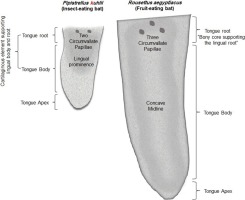当前位置:
X-MOL 学术
›
Acta Histochem.
›
论文详情
Our official English website, www.x-mol.net, welcomes your feedback! (Note: you will need to create a separate account there.)
Anatomical features of the tongue of two chiropterans endemic in the Egyptian fauna; the Egyptian fruit bat (Rousettus aegyptiacus) and insectivorous bat (Pipistrellus kuhlii).
Acta Histochemica ( IF 2.5 ) Pub Date : 2020-01-16 , DOI: 10.1016/j.acthis.2020.151503 Diaa Massoud 1 , Mohamed M A Abumandour 2
Acta Histochemica ( IF 2.5 ) Pub Date : 2020-01-16 , DOI: 10.1016/j.acthis.2020.151503 Diaa Massoud 1 , Mohamed M A Abumandour 2
Affiliation

|
The current study aimed to investigate the tongue (lingual) morphometry, histology, and histochemistry of two chiropterans endemic in the Egyptian fauna, and having different feeding preferences. The tongues of nine adult individuals of each species were utilized in our investigation. The tongue of fruit-eating bat was observed relatively longer than the one of insect-eating bat. Grossly, the insect-eating bat had a lingual prominence on the dorsum of lingual body, while the fruit-eating bat had a concave midline over the lingual body. Histologically, numerous forms of lingual papillae were scattered along the dorsal epithelium of the tongue. The lingual papillae of the fruit-eating bat seem to be well adapted for piercing the skin of a fruit and liquid sap retention. The lingual glands of both species were lodged in the muscular layer. Two main sets were identified; the serous von Ebner's gland usually seen accompanied by the circumvallate papillae and Weber's gland with mixed mucoserous secretions. Von Ebner's gland showed more prominent acidic mucins, while Weber's gland expressed neutral mucins. The lingual epithelium of the fruit-eating bat had an outer covering of cornified non-nucleated epithelium. On the other hand, the insect-eating bat had an outer covering of nucleated epithelium. It is for the first time to record the existence of the entoglossal plates of both species which consisted of a bony core in the fruit-eating bat and a cartilaginous element in the insect-eating bat. The current study represents an attempt to shed more light on the tongue evolution among mammalian vertebrates.
中文翻译:

埃及动物区系中两种特有的翼手动物的舌头的解剖特征;埃及果蝠(Rousettus aegyptiacus)和食虫蝙蝠(Pipistrellus kuhlii)。
目前的研究旨在调查埃及动物区系中两种特有的翼手动物的舌头(舌头)形态,组织学和组织化学,并具有不同的喂养偏好。我们的调查使用了每个物种的9个成年个体的舌头。观察到吃水果的蝙蝠的舌头比吃昆虫的蝙蝠的舌头相对更长。总体而言,以昆虫为食的蝙蝠在舌体的背部有舌突,而以水果为食的蝙蝠在舌体上有凹线。组织学上,舌乳头的多种形式沿舌背上皮散布。吃水果的蝙蝠的舌乳头似乎很适合刺穿水果的皮肤和液体汁液的保留。两种物种的舌腺都位于肌肉层中。确定了两个主要集合;浆液性的冯·埃伯纳氏腺通常见于伴有粘膜分泌物混合的周缘乳头和韦伯氏腺。冯·埃伯纳氏腺表现出更多的酸性黏蛋白,而韦伯氏腺表达中性黏蛋白。吃水果的蝙蝠的舌上皮有一层角质化的无核上皮。另一方面,以昆虫为食的蝙蝠的外壳有核上皮。这是第一次记录这两种物种的牙板的存在,该板由吃水果的蝙蝠中的骨核和吃昆虫的蝙蝠中的软骨元素组成。当前的研究代表了试图更多地揭示哺乳动物脊椎动物舌头进化的尝试。通常见于腺体,伴有周缘乳头和韦伯氏腺,黏膜分泌物混合。冯·埃伯纳氏腺表现出更多的酸性黏蛋白,而韦伯氏腺表达中性黏蛋白。吃水果的蝙蝠的舌上皮有一层角质化的无核上皮。另一方面,以昆虫为食的蝙蝠的外壳有核上皮。这是第一次记录这两种物种的牙板的存在,该板由吃水果的蝙蝠中的骨核和吃昆虫的蝙蝠中的软骨元素组成。当前的研究代表了试图更多地揭示哺乳动物脊椎动物舌头进化的尝试。通常见于腺体,伴有周缘乳头和韦伯氏腺,黏膜分泌物混合。冯·埃伯纳氏腺表现出更多的酸性黏蛋白,而韦伯氏腺表达中性黏蛋白。吃水果的蝙蝠的舌上皮有一层角质化的无核上皮。另一方面,以昆虫为食的蝙蝠的外壳有核上皮。这是第一次记录这两种物种的牙板的存在,该板由吃水果的蝙蝠中的骨核和吃昆虫的蝙蝠中的软骨元素组成。当前的研究代表了试图更多地揭示哺乳动物脊椎动物舌头进化的尝试。腺体表现出更突出的酸性粘蛋白,而韦伯氏腺体表达中性粘蛋白。吃水果的蝙蝠的舌上皮有一层角质化的无核上皮。另一方面,以昆虫为食的蝙蝠的外壳有核上皮。这是第一次记录这两种物种的牙板的存在,该板由吃水果的蝙蝠中的骨核和吃昆虫的蝙蝠中的软骨元素组成。当前的研究代表了试图更多地揭示哺乳动物脊椎动物舌头进化的尝试。腺体表现出更突出的酸性粘蛋白,而韦伯氏腺体表达中性粘蛋白。吃水果的蝙蝠的舌上皮有一层角质化的无核上皮。另一方面,以昆虫为食的蝙蝠的外壳有核上皮。这是第一次记录这两种物种的牙板的存在,该板由吃水果的蝙蝠中的骨核和吃昆虫的蝙蝠中的软骨元素组成。当前的研究代表了试图更多地揭示哺乳动物脊椎动物舌头进化的尝试。食虫蝙蝠的外壳有核上皮。这是第一次记录这两种物种的牙板的存在,该板由吃水果的蝙蝠中的骨核和吃昆虫的蝙蝠中的软骨元素组成。当前的研究代表了试图更多地揭示哺乳动物脊椎动物舌头进化的尝试。食虫蝙蝠的外壳有核上皮。这是第一次记录这两种物种的牙板的存在,该板由吃水果的蝙蝠中的骨核和吃昆虫的蝙蝠中的软骨元素组成。当前的研究代表了试图更多地揭示哺乳动物脊椎动物舌头进化的尝试。
更新日期:2020-01-16
中文翻译:

埃及动物区系中两种特有的翼手动物的舌头的解剖特征;埃及果蝠(Rousettus aegyptiacus)和食虫蝙蝠(Pipistrellus kuhlii)。
目前的研究旨在调查埃及动物区系中两种特有的翼手动物的舌头(舌头)形态,组织学和组织化学,并具有不同的喂养偏好。我们的调查使用了每个物种的9个成年个体的舌头。观察到吃水果的蝙蝠的舌头比吃昆虫的蝙蝠的舌头相对更长。总体而言,以昆虫为食的蝙蝠在舌体的背部有舌突,而以水果为食的蝙蝠在舌体上有凹线。组织学上,舌乳头的多种形式沿舌背上皮散布。吃水果的蝙蝠的舌乳头似乎很适合刺穿水果的皮肤和液体汁液的保留。两种物种的舌腺都位于肌肉层中。确定了两个主要集合;浆液性的冯·埃伯纳氏腺通常见于伴有粘膜分泌物混合的周缘乳头和韦伯氏腺。冯·埃伯纳氏腺表现出更多的酸性黏蛋白,而韦伯氏腺表达中性黏蛋白。吃水果的蝙蝠的舌上皮有一层角质化的无核上皮。另一方面,以昆虫为食的蝙蝠的外壳有核上皮。这是第一次记录这两种物种的牙板的存在,该板由吃水果的蝙蝠中的骨核和吃昆虫的蝙蝠中的软骨元素组成。当前的研究代表了试图更多地揭示哺乳动物脊椎动物舌头进化的尝试。通常见于腺体,伴有周缘乳头和韦伯氏腺,黏膜分泌物混合。冯·埃伯纳氏腺表现出更多的酸性黏蛋白,而韦伯氏腺表达中性黏蛋白。吃水果的蝙蝠的舌上皮有一层角质化的无核上皮。另一方面,以昆虫为食的蝙蝠的外壳有核上皮。这是第一次记录这两种物种的牙板的存在,该板由吃水果的蝙蝠中的骨核和吃昆虫的蝙蝠中的软骨元素组成。当前的研究代表了试图更多地揭示哺乳动物脊椎动物舌头进化的尝试。通常见于腺体,伴有周缘乳头和韦伯氏腺,黏膜分泌物混合。冯·埃伯纳氏腺表现出更多的酸性黏蛋白,而韦伯氏腺表达中性黏蛋白。吃水果的蝙蝠的舌上皮有一层角质化的无核上皮。另一方面,以昆虫为食的蝙蝠的外壳有核上皮。这是第一次记录这两种物种的牙板的存在,该板由吃水果的蝙蝠中的骨核和吃昆虫的蝙蝠中的软骨元素组成。当前的研究代表了试图更多地揭示哺乳动物脊椎动物舌头进化的尝试。腺体表现出更突出的酸性粘蛋白,而韦伯氏腺体表达中性粘蛋白。吃水果的蝙蝠的舌上皮有一层角质化的无核上皮。另一方面,以昆虫为食的蝙蝠的外壳有核上皮。这是第一次记录这两种物种的牙板的存在,该板由吃水果的蝙蝠中的骨核和吃昆虫的蝙蝠中的软骨元素组成。当前的研究代表了试图更多地揭示哺乳动物脊椎动物舌头进化的尝试。腺体表现出更突出的酸性粘蛋白,而韦伯氏腺体表达中性粘蛋白。吃水果的蝙蝠的舌上皮有一层角质化的无核上皮。另一方面,以昆虫为食的蝙蝠的外壳有核上皮。这是第一次记录这两种物种的牙板的存在,该板由吃水果的蝙蝠中的骨核和吃昆虫的蝙蝠中的软骨元素组成。当前的研究代表了试图更多地揭示哺乳动物脊椎动物舌头进化的尝试。食虫蝙蝠的外壳有核上皮。这是第一次记录这两种物种的牙板的存在,该板由吃水果的蝙蝠中的骨核和吃昆虫的蝙蝠中的软骨元素组成。当前的研究代表了试图更多地揭示哺乳动物脊椎动物舌头进化的尝试。食虫蝙蝠的外壳有核上皮。这是第一次记录这两种物种的牙板的存在,该板由吃水果的蝙蝠中的骨核和吃昆虫的蝙蝠中的软骨元素组成。当前的研究代表了试图更多地揭示哺乳动物脊椎动物舌头进化的尝试。


























 京公网安备 11010802027423号
京公网安备 11010802027423号